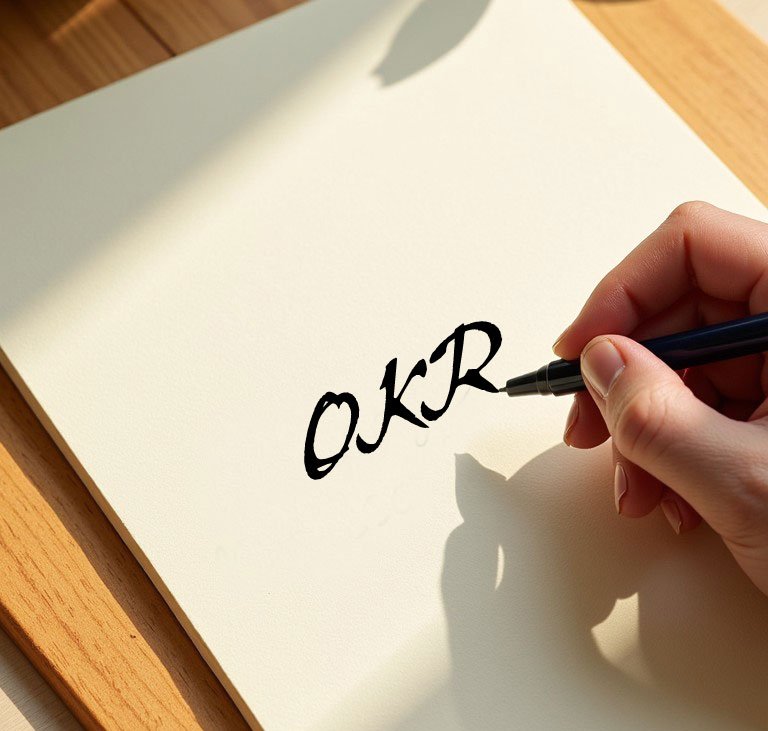Listen and follow
Introduction
We recently wrote an introductory post “OKR is Aspiration, Inspiration and Achievement”. In this article we take a more detailed look at Aspirational OKRs.
The fun part of OKR is dreaming about better days ahead – whether it’s for the company, a department, a team, or even an individual. We call these dreams Aspirational OKRs – but with the OKR framework, there are strategies and disciplines to make those dreams come true.
New to OKRs? See – “What is OKR?”
The OKR Framework is different.
OKR or Objectives and Key Results is a goal-oriented management framework like KPI and MBO. However, the most important feature that sets it apart from other systems, is an always optimistic, ambitious, aspirational focus.
When teams successfully deploy this framework throughout the organization, you get a growth-minded culture where everyone is inspired and eager to help the company meet its aspirational goals – it’s strength in numbers that helps a company raise the bar and compete at high levels.

Fig. 2 – OKR is different
Aspirational OKRs are for everyone.
Company Aspirational OKR.
At the beginning of the planning period, the CEO will brainstorm several Objectives for the company – these are usually ambitious but important and maybe critical for the near future.
The CEO needs to pare down the list to about 3 to 5 – it’s important to keep the list manageable and doable within a reasonable period.
Corporate Objectives could be:
- Objective 1 – Become the market leader in the APAC region
- Objective 2 – Transition all aspects of our business to AI based paradigms
- Objective 3 – Become the ESG advocate and leader in our industry
Teams should cross-check these objectives with all the stakeholders before they are assigned and developed as OKRs.
Department or Team Aspirational OKRs
Department and Team Leaders can accept the CEO objectives (above) as cascaded OKRs.
Otherwise, Department or Team leads should also ask the question, “What are the other departmental or team goals we’d like to accomplish this quarter?” For example, the Marketing team might pose their own OKRs:
- Objective 1 – Become specialists in Digital Marketing – website, social media, SEO
- Objective 2 – Double Brand Awareness in EU countries
I think most departmental leaders already have some idea of what they want to accomplish in the period cycle. OKRs give leaders a framework to apply, execute, and commit to those ambitions—turning dreams into deliverables.
Individual Aspirational OKRs
At the individual level, staff can also accept cascaded Key Results or even OKRs.
Otherwise, individuals creating their own OKRs can be an awkward topic. Many companies implement Google-like directives for all staff to submit OKRs, only to run into problems and settle for upper-level management OKRs only.
To avoid those problems, Team Leaders should contain individual OKRs at the Team Level, so as not to be interpreted as a top-down company directive. This team-leader-staff dynamic keeps the OKRs personal, challenging, and accountable for the individual.
Individual OKRs help improve their working conditions, career skills and team performance.
- Objective 1 – Become the company Photoshop expert.
- Objective 2 – Become team expert in XYZ Product Lines
We’ve noticed that individual development using OKR is contagious – other teams can see the OKR team and individual progress, which encourages them to hop on the OKR train.
Also See – “Making a case for individual OKRs”
Problems with Aspirational OKRs.
Cascading aspirational OKRs can be a double-edged sword – they can be inspirationally challenging, or daunting and intimidating.
The “Afraid To fail” Syndrome.
You have to set the right expectations for Aspirational Goals – yes, they are ambitious and seemingly difficult to achieve. But not achieving an Aspirational Goal does not mean failure, as long as you make progress along the way – and this can be manifested in many ways – For example, you may gain insights for improving products in many different ways. And these small gains should be acknowledged and even commended.
Also, failure to achieve an OKR goal in a cycle period is not the end of the road – You can carry OKRs over into the next quarter taking advantage of new insights gained.
Sandbagging happens … We’re all human.
Sandbagging is where you low-ball your OKRs, so that they are more easily achieved. It’s actually quite natural to do so, a self-preservation mechanism that we may not always be aware of. You can adjust sandbagging by monitoring OKR achievements over time – if someone is always 100% achieving their OKRs, it’s time for an aspirational push.
That said, setting the right amount of “Stretch” is a learning process.
“I don’t have to finish Aspirational OKRs”.
There are “Committed OKRs” and “Aspirational OKRs”. Committed OKRs are expected to be completed 100% – that said, most of the work is under the control of the OKR owner. For example, the operations team has an OKR to move offices to another location because of lease expiration – this absolutely has to get done.
However, with Aspirational OKRs, the expectation is that 70% of the time they are not completed – this, unfortunately, leads some to believe it’s OK to not to complete Aspirational OKRs.
But in fact, there is little difference between Committed OKRs and Aspirational OKRs – they are both promises to complete them at 100%.
The only difference is that Aspirational OKRs have more unknown parameters. Sales Aspirational OKRs tend to be like this, given dynamic global economies and market conditions.
OKRs are seen as a top-down directive.
Ben Lamorte states this in his book “The OKR Field Book”, that while some Googlers found Individual OKRs helpful, others found it a waste of time.
Some companies follow Google’s lead in mandating OKRs for all employees. However, demanding company-wide individual OKRs can be laden with problems. When you do this, It’s like saying “you are required to submit your dreams every quarter” – your OKRs begin to seem more like a chore than your own challenge.
Individual OKRs are best handled at the team level.
I find handling Individual OKRs is best done at the Team Level – the working situation for individuals are better dealt by team leaders, who understand work loads and challenges that staff members face – Perhaps there’s no time for individual OKRs, or there are some skills that an individual lacks.
The team leader asks the individual, “How do you think you can improve your skills to help the team” . At first, the staff member will be surprised, and may need some coaching in the beginning – have them take some time to think about it. Let the individual ponder this question – This process reflects a key OKR aspect: Critical Thinking.
The point is, when individuals can come with their own dreams and it aligns with Team goals, they become committed and accountable.
That said, all Departments and Teams should have an overriding OKR – “The Raise the Bar OKR”.
Should Aspirational Objectives be time-bound?
A lot of people will say no – they say objectives should be purely aspirational, and that Key Results will determine the timeline. I don’t always agree with this because it contradicts the nature of setting goals – A goal without an end time seems ambiguous – there’s nothing to shoot for.
That said, the objective’s end time is only an estimate – there will be cross functional departmental meetings that will examine the end date and teams will adjust timelines appropriately.
Furthermore, here is one of the famous Youtube OKRs from the book “Measure what Matters” (J. Doerr), and it clearly has a date in the Objective (Figure 3).
OBJECTIVE
Reach 1 billion hours of watch time per day [by 2016], with growth driven by:
KEY RESULTS
- Search team + Main App (+XX%), Living Room (+XX%).
- Grow kids’ engagement and gaming watch time (X watch hours per day).
- Launch YouTube VR experience and grow VR catalog from X to Y videos.
Fig. 3 – Youtube Objective by 2016
The Behavioral Advantages of Aspirational Culture
OKR literature often refers to the Big Hairy Audacious Goal (BHAG), a term coined by Jim Collins in this book “Good to Great”. He states:
“A BHAG serves as a unifying focal point of effort, galvanizing people and creating team spirit as people strive toward a finish line. Like the 1960s NASA moon mission, a BHAG captures the imagination and grabs people in the gut.”
It’s this behavioral psychology that fuels OKRs—and it’s up to leadership to consistently nurture it, ensuring aspirational goals are embraced as bold challenges, not burdens.
Conclusion: With Aspirational OKRs, dreams can come true.
The most unique feature of OKR is the optimistic, ambitious and aspirational nature of the framework.
Ambitious goals capture the imagination and instill a feeling of adventure and challenge, and that is a powerful psychological advantage for companies vying for market share in a sea of competitors.
But OKRs must be implemented appropriately – otherwise, you’ll encounter resistance and dissatisfaction in the ranks. And that is why so much emphasis is put on proper Implementation, Coaching and Training.
In organizations, everyone can dream and dream big. And it’s the OKR framework that companies use to make those dreams come true.

Fig. 4 – Dreams come true
References:
Good to Great – Why some companies make the leap … and others don’t – Jim Collins (2001)
The OKR Field Book – A step by step guide for Objectives and Key Results – Ben Lamorte (Copyright 2022)
Measure What Matters – How Google, Bono and the Gates Foundation Rock the World with OKRs – John Doerr (2018)







0 Comments